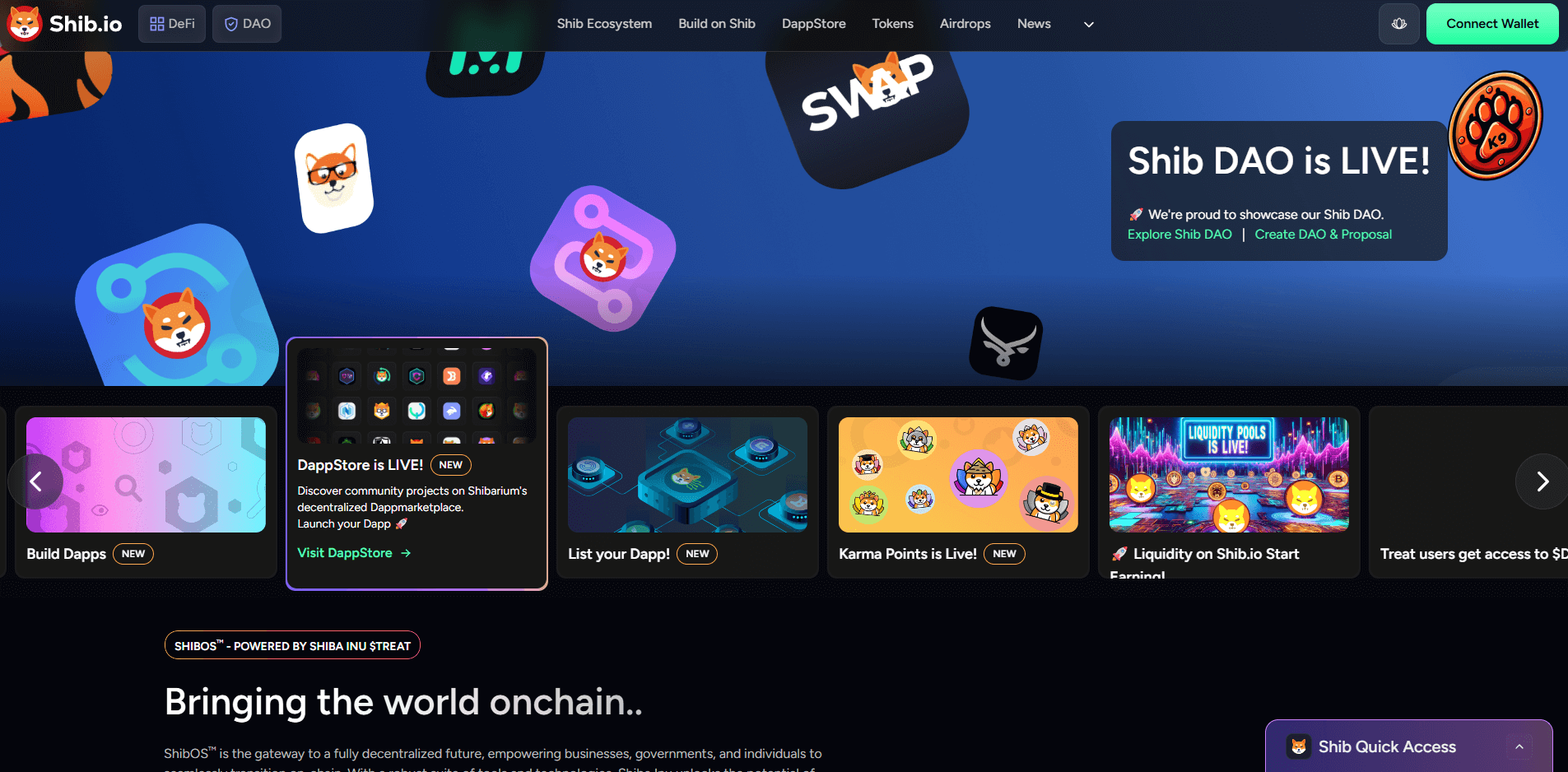 Hey everyone! Today we have some very special guests — the amazing team behind ShibOS, the powerhouse driving one of the most iconic meme coin ecosystems in the world!
Hey everyone! Today we have some very special guests — the amazing team behind ShibOS, the powerhouse driving one of the most iconic meme coin ecosystems in the world!
Chris: ShibOS™ is described as the 'gateway to a fully decentralized future.' What inspired this ambitious vision, and how do you see ShibOS transforming industries as diverse as government, business, and personal finance?
ShibOS Team: ShibOS™ was inspired by the vision of giving people full control over their digital lives, brought to life through a modular system designed for real-world impact. For example, governments can utilize the FHE-powered identity stack to issue digital IDs that citizens can verify without exposing personal data—vital for secure voting, licensing, and public services.
Businesses can leverage Shib Finance to offer decentralized lending and borrowing, powered by users’ verified identities, reputations, and on-chain karma. They can also use the Event & Ticketing Engine to enable transparent, tamper-proof blockchain-based ticketing. For individuals, the Doggy DAO provides a democratic voice in shaping the ecosystem, while gamers and creators can engage with the Super HUB FUN & Tournament Engine and the Shib NFT Collection to earn, play, and build without relying on intermediaries. Together, these technologies position ShibOS as a powerful, practical gateway to a truly decentralized future.
Chris: With Shibarium achieving over 1 billion transactions in just 18 months, what do you believe sets it apart from other L2 blockchains, and how has this rapid growth impacted your strategic direction?
ShibOS Team: That milestone—over a billion transactions in just 18 months—is a reflection of how deeply embedded Shibarium has become within the community. What sets Shibarium apart is twofold:
First, its integration into one of the most passionate and engaged communities in crypto, the Shib Army. And second, its technical design choices that favor speed, affordability, and accessibility.
From an engineering perspective, the growth pushed us to prioritize scalability and decentralization earlier than expected. We implemented optimizations in our infrastructure. The rapid adoption also influenced our strategic direction—accelerating efforts like the developer portal, burn mechanisms tied to real usage, and our rollup framework for enterprise and gaming use cases.
Ultimately, this growth has validated Shibarium not just as a Layer 2, but as the foundation of a broader decentralized network state we’re building across identity, payments, and governance.
Chris: Decentralization and community are at the core of your mission. How do you balance the need for innovation and scalability with the principles of decentralized governance?
ShibOS Team: Team It’s definitely a balancing act—but one we take seriously. Innovation and scalability are essential to keep up with user demand, but for us, decentralization isn’t negotiable—it’s the endgame.
We approach it in layers. For example, when we roll out new features—like Shibarium’s burn mechanisms or our upcoming rollup infrastructure—we start with core engineering principles around openness and modularity. That means making sure systems are composable, interoperable, and eventually governable by the community.
On the governance side, we’re actively integrating tools that shift power to the users—like the Karma Points system, decentralized identity (DID), and voting frameworks that let holders directly influence protocol decisions. We’re also reducing reliance on central infrastructure by encouraging node participation, rate-limiting public RPCs, and promoting external indexing and bridging providers.
So innovation happens fast, but with decentralization built in—not tacked on later. That ensures the network grows with the community, not just in spite of it.
Chris: ShibOS includes over 36 core pieces of technology, from secure encryption to cross-chain solutions. Can you share some lesser-known, but critical, technologies in this stack that you believe set ShibOS apart?
ShibOS Team: One of the lesser-known but critical technologies in ShibOS is its use of Fully Homomorphic Encryption (FHE), which allows computations to be performed on encrypted data without ever exposing the underlying information—this is a game-changer for secure identity management and private financial interactions. Another standout is the Layer-3 rollup architecture on Shibarium, which enables developers to build application-specific blockchains tailored to unique business or regulatory needs, all while inheriting Shibarium’s scalability. Additionally, the Event & Ticketing Engine isn’t just for entertainment—it introduces programmable, verifiable event access that could reshape industries like education or government services. These components, while not as flashy as NFTs or DeFi, make ShibOS uniquely capable of powering real, secure, and customizable decentralized systems.
Chris: The Shiba Inu ecosystem is heavily invested in Web3 gaming, with titles like Shiba Eternity and Lap Dogs. What role do these games play in your overall ecosystem strategy, and how do they drive user engagement?
ShibOS Team: Web3 gaming is a key pillar in our long-term strategy—not just as entertainment, but as a powerful on-ramp into the Shiba Inu ecosystem.
With games like Shiba Eternity and the Lap Dogs, we’re creating immersive experiences that allow users to engage with our ecosystem in a way that feels fun, meaningful, and community-driven. These titles aren’t just about gameplay; they’re layered with Web3 mechanics—ownership, utility tokens, digital identity—that introduce players to decentralized principles without requiring deep technical knowledge.
Gaming also serves as a massive user acquisition engine. It brings in audiences who might not otherwise explore DeFi or smart contracts, and gives them tools like wallets, tokens, and NFTs through gameplay. From there, they often start exploring the broader Shibarium ecosystem—whether that’s governance, staking, or building.
In short, gaming is where culture meets technology. It keeps our community engaged, grows it organically, and plays a critical role in onboarding the next million users to Web3.
Chris: Shiboshis and Sheboshis are not just collectibles but also key to your gaming ecosystem. How do these NFTs enhance the player experience, and what unique mechanics do they bring to the table?
ShibOS Team: Team Absolutely—Shiboshis and Sheboshis are far more than just digital collectibles. They’re evolving into core identity assets within our gaming and broader ecosystem strategy.
In our games, these NFTs unlock special privileges, power-ups, and customizations that enhance gameplay and provide a sense of ownership. They’re designed to be interoperable across multiple titles, meaning your Shiboshi can carry progress, traits, or perks from one game to another—something traditional games just can’t offer.
Beyond gameplay, these NFTs also act as membership badges for deeper community participation.
So instead of isolated use cases, Shiboshis and Sheboshis form the backbone of a connected experience—blending identity, utility, and gameplay in a truly Web3-native way.
Chris: $TREAT serves as the 'key' to ShibOS, while BONE is used for gas and LEASH for exclusivity. How did you decide on this multi-token structure, and how do you ensure each token has a clear, sustainable utility?
ShibOS Team: The multi-token structure of the Shiba Inu ecosystem wasn’t a marketing gimmick—it was a deliberate architectural decision. Each token plays a distinct role, designed to support different layers of the ecosystem and ensure sustainable, long-term utility.
$BONE powers Shibarium—it’s our gas token and the backbone of our L2 infrastructure. Every transaction, every smart contract call, every dApp interaction on Shibarium relies on $BONE. That utility is foundational.
$LEASH was created to represent exclusivity. Whether it’s early access to products, priority in NFT drops, or gated community experiences, $LEASH is your backstage pass to the Shiba ecosystem. It’s intentionally limited and tailored for our most dedicated supporters.
$TREAT is the key to the future—it unlocks functionality across ShibOS, our decentralized operating system. From data layers to reputation systems, gaming integrations to governance—$TREAT is designed to be the incentive and access layer, giving users real power to shape their experience and developers the tools to build meaningful, interoperable applications.
We ensure sustainability through purpose-driven utility. No token exists just to exist—they are tied to real economic, social, or technical functions. And with the ecosystem growing rapidly across gaming, DeFi, identity, and more, each token’s role only becomes more meaningful over time.
Chris: ShibOS positions itself as a movement, not just a platform. How do you foster this sense of belonging and purpose within your community, especially as it continues to grow globally?
ShibOS Team: Absolutely—and that’s really what makes ShibOS special. From the beginning, our vision for ShibOS has never been about launching just another platform. It’s about building a shared digital space where people aren’t just users—they’re citizens of a decentralized future.
We foster that sense of belonging by involving the community at every step. Whether it’s shaping governance through voting mechanisms, contributing to open-source tooling, or participating in ecosystem bounties and quests, we’ve created multiple layers of contribution and ownership. This gives our community purpose beyond just speculation—they’re co-builders.
We’ve also designed ShibOS to reflect cultural inclusivity. From localized dApps to gamified identity layers and NFT integrations like Shiboshis and Sheboshis, every feature is made to resonate across borders. The language of Web3 is often code—but the language of belonging is community. That’s why everything we build puts people at the center.
As we grow globally, we’re focused on decentralized infrastructure with local impact. That means empowering contributors from different regions, supporting education hubs, and making it easy for anyone—regardless of background—to find their place and purpose within the ShibOS ecosystem.
It’s a movement because people believe in what we’re building together. That’s what sets it apart.
ShibOS™ is more than an operating system—it’s a global movement built on the belief that people deserve power over their digital lives. It fosters belonging by giving the community real tools to shape the ecosystem, starting with the Doggy DAO. This isn't just a governance feature; it's a democratic engine where every voice matters. Whether you’re proposing changes, voting on ecosystem upgrades, or supporting initiatives, you’re not a spectator—you’re a stakeholder. This deep sense of involvement turns users into co-creators of the future.
At the core of ShibOS is its groundbreaking FHE-powered identity stack, which empowers users with secure, self-sovereign digital identities. These identities aren’t just static credentials—they’re dynamic reputations that grow with your interactions, trust, and contributions across the Shib ecosystem. Tied to this is karma, a novel system that reflects your credibility, activity, and impact. Whether you're seeking microloans through Shib Finance, engaging in peer-to-peer services via Shib Business, or accessing community-vetted opportunities, your identity and karma unlock trust in a trustless world.
As the ecosystem grows, so does the need for flexibility and scalability—which is why ShibOS supports custom Layer-3 rollups built on Shibarium. These allow developers, organizations, and even governments to deploy specialized blockchains tailored to their needs—whether it’s for public records, private commerce, or community apps—while staying interoperable with the larger ecosystem. This modularity ensures no one is left out, and every local problem can find a decentralized solution.
And when it comes to everyday use, Shib Pay brings it all together by enabling fast, gas-optional transactions powered by identity and karma. Imagine buying goods, tipping creators, or funding causes using Shib-native payment flows that are secure, user-friendly, and community-driven.
What makes ShibOS a movement isn’t just its tech—it’s the purpose behind it. It’s about dignity, agency, and a future where people, not platforms, hold the keys. Whether you're building, transacting, governing, or just exploring, ShibOS invites you to belong, contribute, and lead in a decentralized world built by all of us.
Chris: What excites you the most about the future of the Shiba Inu ecosystem, and where do you see the project in the next 5 to 10 years?
ShibOS Team: What excites me the most is that we’re just getting started—despite everything we’ve achieved, the real potential of the Shiba Inu ecosystem is only beginning to unfold.
We’re evolving from a meme-born community into a full-fledged decentralized nation-state with its own identity, infrastructure, and economy. Between Shibarium as our L2 foundation, ShibOS as a decentralized operating system, the gaming vertical, DeFi tools, identity layers, and now expanding into privacy tech and real-world use cases—this isn’t just an ecosystem, it’s an entire movement.
Looking 5 to 10 years ahead, I see the Shiba Inu ecosystem as a dominant force in Web3—not just in terms of user numbers or market cap, but in how it redefines digital citizenship and governance. We want to be the most community-owned and community-driven network in the world. A place where developers build without permission, where every token has utility, where NFTs have narrative value, and where even your identity and reputation can be self-sovereign and portable.
It’s ambitious, yes—but the excitement comes from knowing we have a community and a roadmap to get there.
What excites me most about the future of the Shiba Inu ecosystem is the deep sense of purpose and unity that fuels it. This is more than a blockchain project—it’s a global movement of people who believe in building a world where power is shared, not hoarded, and where trust is earned through transparency and community. What began as a playful idea has become a serious force for change, driven not by corporate interests, but by real people who care deeply about creating something better—for themselves and for future generations.
In the next 5 to 10 years, I see the Shiba Inu ecosystem becoming a foundation for real-world transformation. It will empower individuals to reclaim ownership of their digital lives, allow creators to thrive without gatekeepers, and offer businesses new ways to operate with integrity and trust. Even governments, seeking more transparent and participatory systems, will look to the values and innovations of this ecosystem for guidance. It will be a space where everyone—from a student in a remote village to a policymaker in a capital city—can find tools, support, and belonging. The most beautiful part? It won’t be built by a single entity or corporation—it will be shaped by all of us, together. And that, more than anything, gives me hope.





 usdt
usdt xrp
xrp

